by Norman Neave
Mtubatuba, South Africa
Summary: Faced with invasive weeds, the managers of Boomerang Farm used holistic decision-making to create an environment that favors the plants we want.
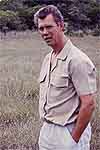
I was introduced to Holistic Management in November 1995 at an overview given by Dick Richardson at our Beef Study Group meeting. What was said that day had me really thinking and I went ahead and bought Allan Savory's first book, Holistic Resource Management. In January 1996 I did my first Introductory Course in Holistic Management facilitated by Kirk Gadzia and returned home to the farm fired up and ready to change our whole approach on management. Unfortunately I ran into a brick wall as none of the other management team had as yet been introduced to Holistic Management, let alone done a course on it. Talking pays off and over the next few months a temporary Holistic Goal was written, with part of the future resource base being functioning riparian areas.
Our whole area was once a grassland/wetland area with vast herds of grazing herbivores, namely buffalo, wildebeest, and large numbers of elephant. The early hunting industry in the 1800s and the tsetse fly campaign in the early 1950s exterminated these, leaving us with what we have today, more bush and the alien invader plants. Most of this formerly wild land now grows sugarcane or eucalyptus trees used for paper pulp. Rainfall averages around 750mm (30") yearly. It falls mainly from October through February (summer), but can be very erratic with long dry periods. Brittleness is thus around 6.
Boomerang Farm is also part of the Nyalazi Conservancy, which borders the Greater St. Lucia Wetland Park. One of the major "problems" challenging the area was the invasion of Alien Invader Plants, notably Chromolaena odorata, a perennial native of the Neotropics from southern Florida to north-western Argentina. It is thought to have entered Kwa-Zulu Natal in seed-contaminated packing materials offloaded at Durban harbour during World War II but its exact origin is still unknown. It has spread far and wide within South Africa as well as into Swaziland, Mozambique, Zimbabwe and Botswana.
Chromolaena is now viewed as a major threat and large amounts of money are being spent to combat it. At a Conservancy meeting a decision was made along conventional lines to rid the Ngodweni stream, which runs through all properties in the Conservancy, of Alien Invaders. The stream was no longer a functioning waterway. Work started on it in June 1996. Each property was handled independently by its own managers. Unlike the others, we were now making decisions that would move us towards our Holistic Goal, and making decisions on the tools to use. These included technology, animal impact, and grazing. The tool of fire was not used at all. The following pictures show what happened.
| 1. Dam site on Ngodweni stream 1963, overflowing and showing a healthy functioning waterway. |
Ralph Dobeyn
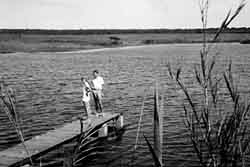 |
| 2. What the whole waterway looked like in June 1996. Completely overrun by alien plants (Chromolaena odorata, Syringa, Bugweed and Lantana). |
Norman Neave
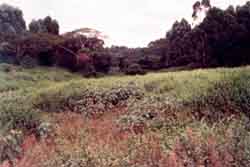 |
Conventional management regards weeds like these as problems. Holistic Management helped us realise the underlying causes:
- We managers did not understand the underlying cause of our "problem" and had only addressed symptoms.
- We did not know exactly what we wanted.
- Our decisions had not taken into account the environmental, social and financial sides.
Our "weed problem" came about because destruction of the wild herds eliminated grazing and animal impact from our area. (Animal impact is everything grazing animals do except graze. It includes trampling, dunging, etc.) The resulting overrest killed grass plants and allowed bush to invade. In these conditions, tap rooted alien invader plants found ideal conditions to germinate and grow, while grass seedlings could not survive.
We decided to use grazing and animal impact to re-establish good conditions for grasses. The grasses would in turn create a hostile environment for the invaders.
| 3. Dam site August 1998. Cleared of invaders but a completely dry dam indicating an ineffective water cycle. Note remains of dock in foreground. |
Norman Neave
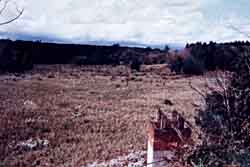 |
| 4. Further upstream from dam site August 1996—Alien Invaders. Note tree with flat crown slightly off center to the left, my fixed point. |
Norman Neave
 |
| 5. August 1997. Aliens have been impacted by a tractor and slasher, manual labour, ring barking trees and treating with a herbicide. Livestock is also being herded into the area. Note fixed point tree. |
Norman Neave
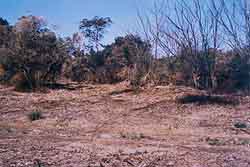 |
| 6. Another view of the impacted area. At this point we could use livestock to break the hard cap (crust) on the soil surface with their hooves. This allows dormant grass seed to re-establish. |
Norman Neave
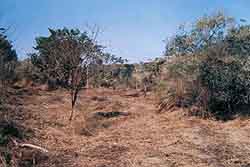 |
| 7. Our working herd in another area, also part of our Holistic Grazing Plan. We monitor to make sure plants get enough recovery time before the cattle come back. |
Joy Livingwell
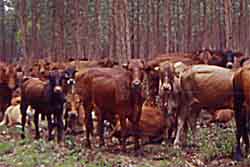 |
| 8. January 1998. The dormant grass seed have come alive. Fixed point tree in background. |
Norman Neave
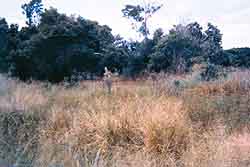 |
| 9. Having established favourable conditions for grasses, the tools of animal impact and grazing now maintain them. |
Norman Neave
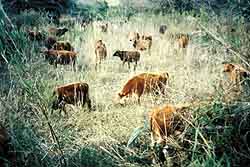 |
| 10. October 1999. Another view of the returning grass sward, taken just after the cattle grazed it. |
Norman Neave
 |
| 11. Further upstream. Photo taken from a causeway crossing the stream which is the boundary between Boomerang (us) and the neighbours. Cattle have just grazed here. October 1999. |
Norman Neave
 |
| 12. Directly opposite. The stream on the neighbours' side. Tools used being only technology and manual labour. Note part of wooden post in left foreground, my fixed point. October 1999. |
Norman Neave
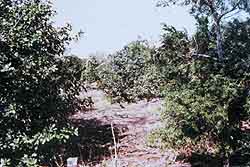 |
| 13. 9th March 2001. Photos taken from exactly the same point as above. The neighbours' side. Alien plants have returned en mass and the costs of herbicide and labour have also increased every year since 1996. The Department of Agriculture budgets R2500/ha for areas like this with 100% Chromolaena cover. |
Norman Neave
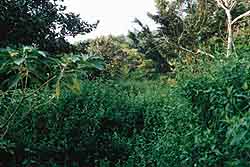 |
| 14. Directly opposite, same place as photo 11. Boomerang Farm with a fine healthy swath of grass—creating a hostile environment for tap rooted alien invader plants, and an area falling into the Holistic Grazing plan of the farm. In total an area of over 43 hectares (106 acres). |
Norman Neave
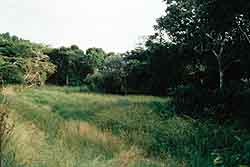 |
This is now a beautiful area to walk in. Abundant bird life and small game has returned. The soil surface has good litter cover, helping it retain moisture. We are moving towards a healthy water and mineral cycle, with the grass taking up solar energy. We make maximum use of this energy by producing and marketing beef from land that was formerly unhealthy and unusable by us and most wildlife. Our "weed control" thus produces social, environmental, and financial benefits rather than costs.
| 15. The dam site on the waterway with water in it. 9th March 2001. |
Norman Neave
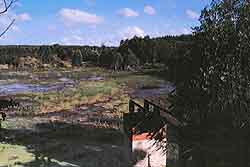 |
—Norman Neave
© August 2002
Norman Neave is a Holistic Management Certified Educator. Contact him in Mtubatuba, South Africa at 27-35-5504150. Email: norboom@saol.com
Posted 26 August 2002